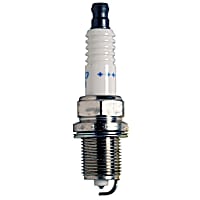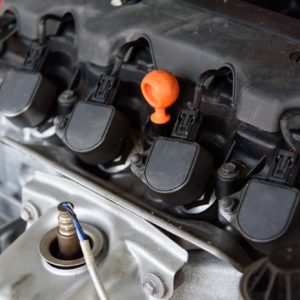The P0351 code appears when the powertrain control module (ECM/PCM) perceives a problem with the cylinder #1 ignition coil or its circuit.
What Does the P0351 Code Mean?
Diagnostic Trouble Code (DTC) P0351 stands for “Ignition Coil ‘A’ Primary/Secondary Circuit.” It indicates that there’s a potential problem with the cylinder #1 ignition coil or its circuit.
Every ignition coil has a “primary” winding and a “secondary” winding. The primary winding is the part of the ignition coil that is triggered by a switching device so that the secondary winding creates the necessary high voltage spark.

Since the ECM/PCM is triggering the primary of each coil or each pair of coils, it has the ability to watch the voltage spike created by the primary winding each time it triggers the secondary winding, and if the ECM/PCM doesn’t see the primary voltage spike it knows there is a problem of some kind with the primary and possibly the secondary elements of the coil or coil pack.
If the secondary part of the ignition coil is shorted out, the primary spike will be weak as a result. That’s when it typically sets the P0351 code if the fault is on cylinder #1.
You may also watch this video to understand how ignition coil works:
Note: The definition of code P0351 may be different depending on the vehicle manufacturer. Consult the appropriate repair manual or repair database for the exact code definition.
For an in-depth discussion of how the primary and secondary windings of the ignition coil work, including a brief history and how they are used in various vehicles, read our explanation here.
What are the Possible Causes of the P0351 Code?
OBD-II codes have several possible causes, and the P0351 code is no different. Below are some of the most likely causes of the P0351 code:
- Faulty ignition coil/s
- Issues with the ignition coil circuit
- A problem with the PCM, such as software in need of an update (this is very, very rare).
- A problem with cam sensor synchronization may cause multiple coil primary faults, but this is also very rare.
What are the Common Symptoms of the P0351 Code?
A combination of the symptoms listed down below may indicate that you’re dealing with the fault code P0351. As soon as you encounter these symptoms, use a scanner to verify the issue.
- Check engine light is on but no other symptoms at all
- Engine runs and idles rough sometimes or all the time
- Engine misfires sometimes or all the time (the issue often gets worse upon acceleration)
How to Diagnose the P0351 Code
Given that the engine code P0351 has multiple likely causes, reaching a proper diagnosis of the problem will prove quite a challenge. Luckily, there are a lot of online resources for the average DIYer to help with this process. Here is a link to a video resource that shows what the troubleshooting process might involve the P0351 code:
How to Fix the P0351 Code
After diagnosis, the next step to fixing the P0351 code is research. Search for confirmed fixes that are specific not only to what triggered the code in your vehicle but also to your car’s year, make, and model. Consult online auto repair resources and guides for factory information.
If you’re not certain that your automotive knowledge and DIY repair skills are up to the task, it may be best to let your mechanic resolve the issue.

Other Notes About P0351
If your vehicle’s computer detects a problem in the ignition coil circuit, it may send the ignition coil circuit codes P0351-P0358. The last digit of these codes refers to the cylinder where the issue is located. Repair and diagnosis procedures might differ according to the cylinder. Ignition coil problems often trigger the misfire codes P0300-P0308.
A Closer Look at How the Primary and Secondary Windings of Ignition Coils Work
As mentioned, every ignition coil has a “primary” winding and a “secondary” winding. The primary winding is the part of the ignition coil that is triggered by a switching device so that the secondary winding creates the necessary high voltage spark.
Every ignition coil has a “primary” winding and a “secondary” winding. The primary winding is the part of the ignition coil that is triggered by a switching device so that the secondary winding creates the necessary high voltage spark.
–Richard McCuistian, ASE Certified Master Automobile Technician
Oil-filled Ignition Coils
On pre-electronic ignition vehicles, the switching device was a set of contact points in the distributor that were opened very rapidly by small “bumps” (cams) on the distributor shaft and closed by spring pressure. There is also a condenser wired in parallel with the points, but that’s for another lesson.
On the old, round oil-filled coils that were triggered to fire by those points, there are three terminals. The center coil terminal is the secondary terminal – that’s where the high voltage spark makes its exit from the coil through that fat wire leading to the center of the distributor cap. Underneath the distributor cap, the spinning rotor sorts out the spark and delivers it to the spark plugs in their respective cylinders at the proper time and in the proper order.
The other two terminals on the ignition coil are smaller. One of those terminals is marked + (plus, positive) and power from the ignition switch is delivered to this terminal through a resistor or a resistor wire when the vehicle is running, but that resistor or resistor wire is bypassed while the vehicle is cranking. The other small coil terminal is marked – (minus, negative) and leads to the points in the distributor. When the points are open, no current is flowing through the ignition coil. As soon as the points close, current begins to flow through the primary windings.

When the points in the distributor are closed, the primary winding is rapidly building a magnetic field that is saturating an iron core to strengthen the field, which also saturates the secondary windings.
There are only a few hundred primary winding loops compared to the thousands and thousands of secondary winding loops. This magnifies the voltage exponentially when the ignition coil fires. As the cam bump on the spinning distributor shaft opens the points to break the circuit, the magnetic field that has been saturating both sets of windings collapses, and when that happens, a massive burst of voltage is induced in the secondary windings and travels to the appropriate spark plug, jumping the plug gap and triggering a combustion event. At the same instant, the primary winding creates a voltage spike of about 400 volts – that’s important, so remember it.
Again, this cycle happens repeatedly while the engine is running, creating one spark to trigger each combustion event.
Ignition Coils: Mid-’80s to Present
Ignition systems began to evolve (beginning in the mid-70s with GM’s HEI ignition) so by the mid-80s, oil filled coils began to disappear and were replaced by E-core ignition coils that worked the same way the oil filled coils did, except that the voltage increased from about 50,000 volts to nearly 100,000 volts. In the mid-80s, distributors began to disappear, replaced by coil packs that fired pairs of “companion” cylinders (those are the cylinders where the pistons always reach TDC at the same time).
Motorcycles have used this kind of ignition for literally decades, but there are still primary and secondary windings in the coil pack. Coil pack systems have no direct connection between the primary and secondary windings the way old single coils did, and they also require a crankshaft sensor and an ignition module that receives the crank sensor signal and triggers the firing of the coils. Later, the ECM/PCM began to receive the CKP signal and control the coil primary triggers.
Finally, engineers decided to let each cylinder have its own ignition coil, either mounting a coil very near the plug with a short plug wire or, more commonly, mounting the coil right above the spark plug. This is beneficial because the ignition timing can be altered for just one cylinder if the knock sensor picks up a “ping” on that cylinder.
Where to Get New Ignition Coils to Fix Code P0351
Idling and misfires are some of the symptoms of the P0351 code. They can make driving difficult and risky, so don’t waste time determining and resolving the cause. If bad ignition coils triggered the code, replace them as soon as possible. Lucky for you, CarParts.com has you covered.
We source our ignition coils from the most trusted brands in the industry to ensure they pass the highest quality control standards. Rest assured that you’re getting nothing but the best for your vehicle.
Shop on our website or mobile app and get the parts you need without leaving the comfort of your home. Get your new ignition coils in as fast as two business days after ordering them. We also offer low-price and lifetime replacement guarantees to give you more bang for your buck.
Shop now to resolve this trouble code in no time!
Products Mentioned in this Guide
Any information provided on this Website is for informational purposes only and is not intended to replace consultation with a professional mechanic. The accuracy and timeliness of the information may change from the time of publication.


 Ignition Coil
Ignition Coil
 Ignition Coil Wire
Ignition Coil Wire
 Spark Plug
Spark Plug
















